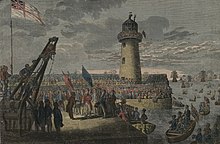Port of Holyhead

The Port of Holyhead (
History

Formerly subservient to
In 1845, an Act of Parliament led to the construction of the new port, and a new railway station was opened in 1851.
In 1916, a naval base was created and the Irish Sea Hunting Flotilla was established later in the
In the late 20th century, the port was owned by Sealink (later Stena Sealink), a ferry company which ran a fast ferry from the Admiralty Pier and slower ferries from an alternative berth. The Irish ferry company B&I also operated ferries to and from Ireland from the port of Holyhead. B&I took Sealink to court in 1992 for imposing less favourable conditions on its competitor when using the port. In the following year, another company, Sea Containers Ltd, took legal action against Sealink Ports on similar grounds.[10] Stena Line discontinued its fast ferry service in 2015,[11] leaving Irish Ferries operating the fastest service between Holyhead and Dublin.[12]
Current services

References
Notes
- ^ "Sea Passenger Statistics 2007". 29 May 2008. Archived from the original on 22 November 2008. Retrieved 14 December 2008.
- ^ a b "Holyhead". Ports and Harbours of the UK. Retrieved 26 April 2016.
- ^ a b c d Phil Carradice. "The opening of Holyhead's new harbour". BBC Blogs - Wales. Retrieved 26 April 2016.
- ^ John Maxwell Dunn (1948). The Chester & Holyhead Railway. Oakwood Press.
- ^ ISBN 978-1-4456-5153-8.
- ISBN 978-0-7083-2214-7.
- ^ Joseph Hone (7 July 1953). "Queen Victoria in Ireland, 1853". History Today: Archive. Retrieved 26 April 2016.
- ISBN 0727725769.
- ^ a b Ann Roberts. "Brief History of the Holyhead Port". www.holyhead.com/holyheadporthistory. Archived from the original on 10 September 2011. Retrieved 26 April 2016.
- ISBN 978-90-6215-804-1.
- ^ Owen Hughes (4 February 2015). "Stena Line fast ferry service from Holyhead to Ireland scrapped after passenger numbers fall by 90%". WalesOnline. Retrieved 26 April 2016.
- ^ "Dublin Swift". Irish Ferries. Retrieved 26 April 2016.
Bibliography
- Cowsill, Miles; Hendy, John (1996). Holyhead-Dun Laoghaire: From Car Ferry to HSS 1965–1996. Narberth, Pembrokeshire: Ferry Publications. ISBN 1871947383.
- Merrigan, Justin (2016). Dun Laoghaire Holyhead 1826–2015: The rise and decline of Ireland's premier route. Ramsey, Isle of Man: Ferry Publications. ISBN 9781906608828.
